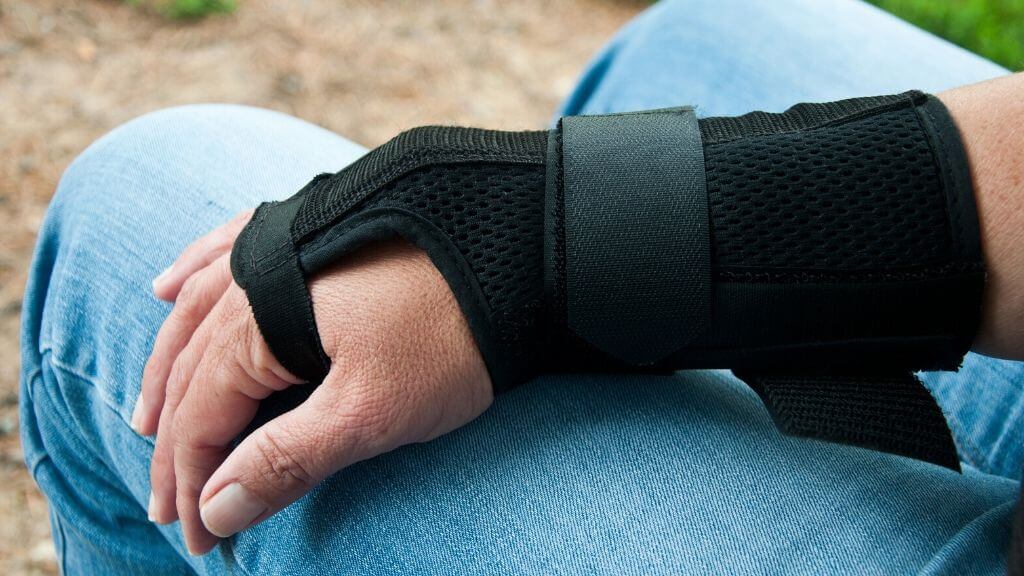There is a nerve located on the palm side of your hand, and it’s the compression of this nerve that leads to carpal tunnel syndrome. The condition is so named because that section of the hand is also referred to as the carpal tunnel.
This nerve is responsible for your ability to feel sensations in your thumb and fingers. The compression to this nerve is typically caused by swelling in your wrist and can occur in one or both of your hands.
What Causes Carpal Tunnel Syndrome?
The pain you feel with carpal tunnel syndrome comes from pressure and swelling in your wrist and sometimes obstructed blood flow. The condition can be made worse by overextending your wrist repeatedly, poor wrist position when using a keyboard or piano, prolonged exposure to vibrations from power tools, or incorrect positioning when using a mouse or computer keyboard at work.
There are also several conditions known to be linked to increased risk for carpal tunnel syndrome such as diabetes, fluid retention from pregnancy, high blood pressure, rheumatoid arthritis, thyroid dysfunction, and trauma to the wrist.
Women are more likely to develop this condition over men, and it is most frequently diagnosed between the ages of 30 and 60. Wrist movements, lifestyle choices, and certain health conditions can all cause carpal tunnel syndrome.

Carpal Tunnel Syndrome Symptoms
The compression of the median nerve allows for most symptoms to be felt along this path. You may find that your hand falls asleep regularly or you drop things for no reason. In addition to this, the signs of carpal tunnel syndrome you will notice are:
♦ Numbness, or tingling, and pain in your thumb and first three fingers
♦ Wrist pain at night that interrupts sleep
♦ Weakness in your hand muscles
♦ A burning sensation that travels up your arm
Carpal Tunnel Syndrome Diagnosis
Your doctor will be able to diagnose carpal tunnel syndrome after discussing your symptoms and performing a few tests. They will often start with your history to review any pattern of your symptoms.
A physical examination is also done to test finger dexterity as well as hand muscle strength. Your doctor may also attempt to verify any pain while performing certain activities such as holding a phone or gripping a steering wheel.
Special testing such as x-rays and electromyograms may also be done for a complete diagnosis. This will rule out any fractures or muscle damage that could be a cause for similar pain.
Carpal Tunnel Syndrome Treatment
For the best results, treatment for carpal tunnel syndrome needs to start soon after symptoms begin to appear. The most common treatment options your doctor will prescribe are:
♦ NSAIDs: These anti-inflammatory medications like ibuprofen can help to relieve the pain caused by this condition. It is important to note that this is usually only short-term relief, and there is no evidence that NSAIDs improve the overall condition.
♦ Corticosteroids: Injections with corticosteroids to relieve pain is also common. Often an ultrasound is used to guide the injection directly to the right place in your wrist. These drugs effectively reduce swelling, which reduces pressure in the wrist and can bring relief to a compressed median nerve.
♦ Wrist splinting: This is particularly useful at night when the condition disrupts sleep. Splinting the wrist will relieve tingling and numbness so you can sleep better.

Carpal Tunnel Syndrome Diet
Much of the pain is caused by a compressed nerve, and there are certain foods you can add to your diet to help reduce any pain-causing inflammation and ease symptoms.
The best foods to add to your diet if you are living with carpal tunnel syndrome include:
♦ Red bell peppers: These, along with other brightly colored produce such as tomatoes and carrots are full of powerful antioxidants and anti-inflammatory compounds that can help alleviate any pain and possible wrist swelling.
♦ Spinach: All leafy greens like spinach are not only full of antioxidant compounds to help ease pain and inflammation, but they are also a great source of vitamin B6. This vitamin has been shown to be a complementary therapy for those with carpal tunnel syndrome.
♦ Salmon: Salmon, as well as other fresh-caught fish, are full of omega-3 fatty acids (DHA and EPA) that deliver anti-inflammatory and antioxidant benefits to those with carpal tunnel syndrome.
♦ Walnuts: These nuts contain a different omega-3 fatty acid called ALA, which is just as beneficial for carpal tunnel relief. It is not found as often in food, so adding walnuts as well as other foods like chia seeds and flaxseeds will make sure you get what you need.
♦ Pineapple: This tropical fruit contains an enzyme known as bromelain that is effective at breaking down inflammation. This makes it a great food source for preventing carpal tunnel syndrome or significantly reducing symptoms.

Natural Treatments for Carpal Tunnel Syndrome
There are also alternative treatment options that work to alleviate symptoms and help you live more comfortably with carpal tunnel syndrome.
You can try yoga to help stretch and strengthen the wrists and hand muscles, and there is also hand therapy designed to improve joint health and grip strength. Ultrasound therapy may also help by increasing the temperature of a specific area of tissue to reduce pain.
You can also make valuable lifestyle changes to help reduce pain and successfully treat carpal tunnel symptoms.
♦ Lose weight to reduce excess fat storage and pressure as well as lower blood pressure
♦ Avoid sleeping on your hands
♦ Take short breaks from repetitive tasks that involve your hands
♦ Wear splints during the day
♦ Avoid actions that flex your wrist and keep them in a neutral position as much as possible
♦ Try carpal tunnel syndrome exercises that rotate and stretch your wrists often especially if you perform daily activities with your hands
♦ Elevate your hands as often as possible
Carpal Tunnel Syndrome Surgery
In some cases, symptoms do not respond to other treatments, and surgery may be an option. Surgery is designed to relieve pressure on the median nerve by one of two ways.
♦ Endoscopic surgery: using a telescope-like device, surgeons cut the ligament that is putting pressure on the nerve.
♦ Open surgery: an incision is made in your palm to cut the ligament, but this is risky and can lead to infections, scar formation, and possible nerve injuries.

Carpal Tunnel Syndrome Statistics
♦ More than eight million people are affected by carpal tunnel syndrome each year.
♦ According to the National Institute for Occupational Safety and Health, carpal tunnel surgery is the second most common type of occupational hazard reported.
♦ Women are twice as likely to develop carpal tunnel over men
In the U.S, there is over $7.4 billion in worker’s compensation costs related to carpal tunnel.
♦ Almost 8 ounces of force is required to press a key when typing, which means almost 16 tons of force will be exercised by your fingers.
Carpal Tunnel and Disability
Carpal tunnel syndrome can cause severe pain and numbness in your hand, which can disrupt work. This is especially problematic if you work with your hands such as typing, or with power tools. Often wearing a splint while working can help alleviate symptoms, but this is not always the case.
With medical documentation supporting the severity of your carpal tunnel syndrome, it may be possible to be eligible for disability. Rigorous testing is required for this to prove that there is no longer an ability to perform work functions as a result of severe loss of dexterity in the hand.
What Is the Long-Term Outlook?
Carpal tunnel syndrome can be painful and very disruptive to your life and your job. If you have noticed the symptoms for a long time, you need to consult your doctor, so treatment and support can be started. There are medications, home remedies, and medical interventions that can help improve the use of your hand, reduce pain, and alleviate symptoms.
Early diagnosis is the key to getting carpal tunnel syndrome treated, and the only way to prevent permanent nerve damage.






